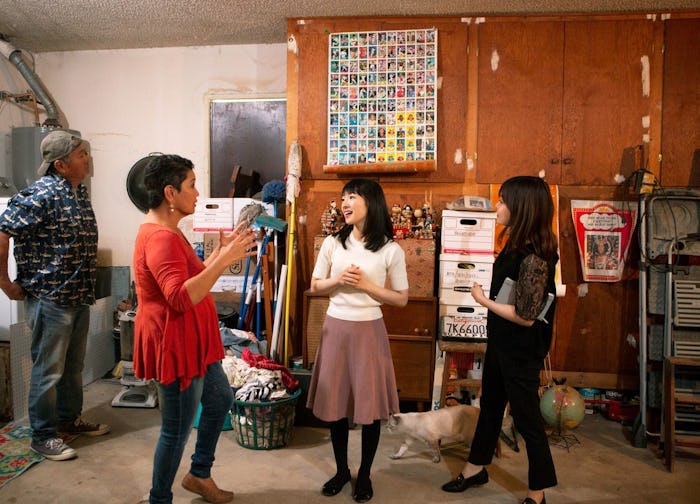Life

What I Want My Kids To Understand About KonMari & Japanese Culture
I always admired Mr. Miyagi. In fact, you could say that he was a childhood hero of mine. He inspired many an epic martial-arts battle between my brother and I during the golden age of WWE, when all the other kids wanted to be Hulk Hogan or Randy Savage. As an adult, I find myself admiring the way Marie Kondo provides strategies for helping clients fight epic battles against the clutter in their homes. Both Mr. Miyagi and Marie Kondo provide mainstream America with a small sampling of Japanese culture, with respective roots that date back a long way. And as an Asian-American mother, I struggle with ways to introduce and support that culture and language — which I was not raised in — while providing my children with a sense of authenticity.
My brother and I grew up in a very rural area where we were more likely to encounter an extraterrestrial in a neighbor’s field than see anyone else that shared our Asian features. We were raised by a Caucasian father and stepmother back when no one really knew or understood the importance of cultural identity, much less teaching it to their children. While my brother and I had Mr. Miyagi, the adults around us had racist family members, folklore about Pearl Harbor and Hiroshima, and whatever was on television to supplement their limited knowledge of our Asian culture.
Today we have access to an almost unlimited amount of knowledge about anything we could ever want to know. Even so, one thing has remained pretty consistent, and it is the lack of Asian culture represented on screen for my children to see. Whereas I had Teenage Mutant Ninja Turtles, my children have Tidying Up With Marie Kondo and Crazy Rich Asians, both of which have taken America by storm, both stripped somewhat of their culture.
The KonMari method has its roots in the Japanese tradition of Shinto animism, the idea that each item has a spirit, or kami — as well as the philosophy of mottainai, which incorporates respect for items, but that doesn’t come across in the show, where Marie Kondo simply explains that people should feel for whether an item “sparks joy,” in deciding whether to keep it. Rather than teaching kids how to fold, I want them to respect their belongings, and to take nothing for granted.
The lack of explicit attention to broader themes of consumption and inheritance are not surprising. Japanese and Asian culture are so much more than the way Netflix or Hollywood represent them, and as a parent learning for herself what these cultures mean to her, I have the responsibility to decide how to introduce them to my children. Thankfully I have the internet and the recent discovery of my long-lost Japanese father to provide me aid on this parenting endeavor.
One thing that was lost to me for most of my life was the story of my Japanese lineage. Something that is very important in Asian culture is the telling of its stories of origin. The past matters. Tradition matters. I have always wanted to be able to provide my children with the ability to tell their family story. Thanks to the internet and my biological father, I can now share with them the naval port village that their grandfather and his family were from. I can share its history and importance, as well as our own ancestral role there. Thanks to FedEx, we have Japanese hangings sent from family abroad to help my children become familiar with the imagery of our culture. We were also sent children’s song books to help us teach a cultural equivalent to nursery rhymes. These are the belongings that matter. I want my kids to know why we hang onto them. And with the advent of apps, programs, and FaceTime, we can begin learning and using the language at home with our children all for the sake of passing along tradition to the next generation.
In Japanese culture, the collective holds just as much, if not more, importance than self. This is somewhat in contrast to Marie Kondo’s philosophy, which focuses on things that spark individual joy. In Japan, everyone expresses a deep respect for each other within their community. This level of respect reflects in how they perform their job duties, to how they enter and exit public transportation, to the cleanliness of their streets. There is an understanding that each individual has a responsibility to conduct themselves in a way that would benefit others. My family lives that philosophy out in ways that go beyond what our society considers to be good manners, like saying “please” and “thank you.” For example, we demonstrate a respect for the people who serve our food by ensuring our table is left without the evidence a toddler and infant have dined there. When approached by staff assuring us that cleanup is not necessary, we explain our desire to model for our children what it means to show respect in all ways. It's not about a minimalist aesthetic, it's about the ritual of cleaning.
I know these examples seem small, but they mean so much to my family and I, and will mean even more to our children one day. The effort we put in now to helping our children understand and appreciate their cultural heritage will help benefit their children and the community around them. So while American society consumes the KonMari method of tidying up, or longs for the lavish lifestyle of Crazy Rich Asians, I will focus on teaching my children another side of Asian culture. After all, in broken English that reminds me of my relatives, Mr. Miyagi reminds me his teachings are a "lesson for whole life," following which, "whole life have a balance."